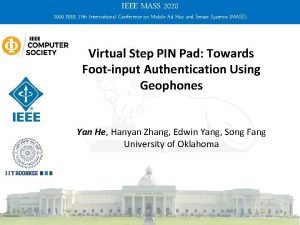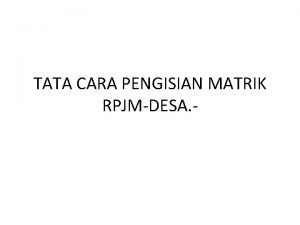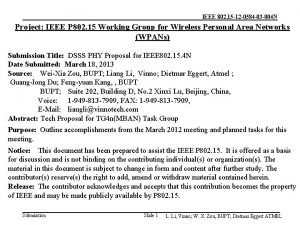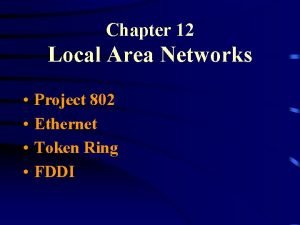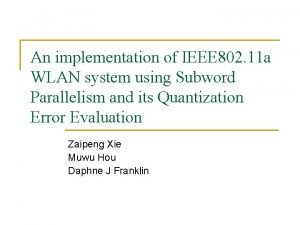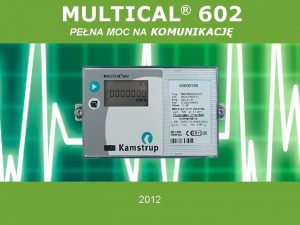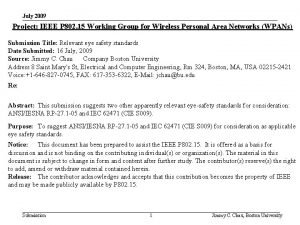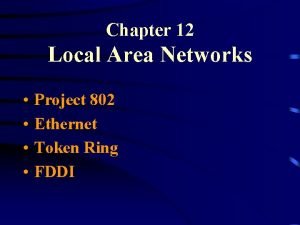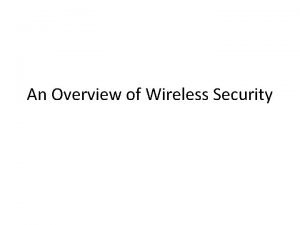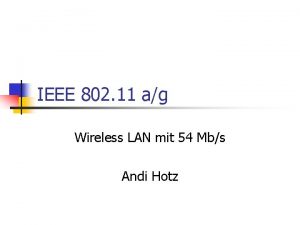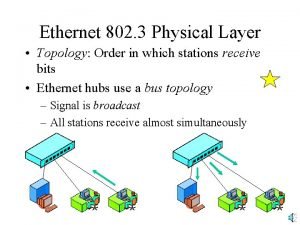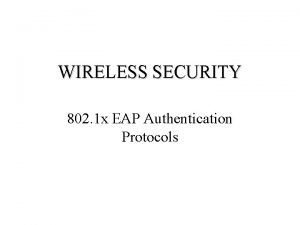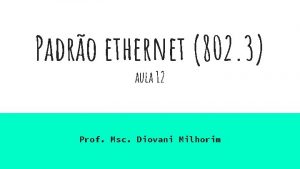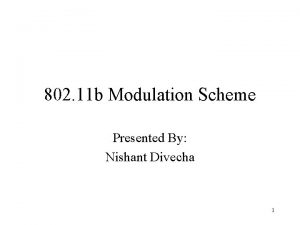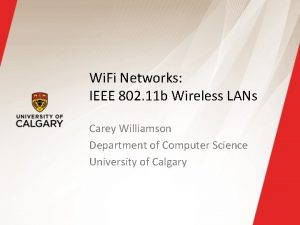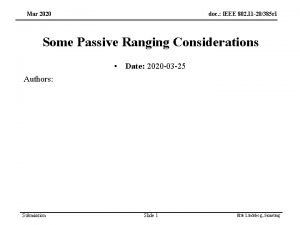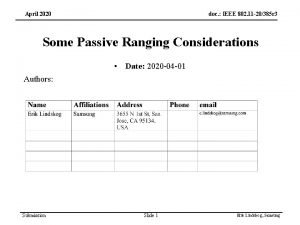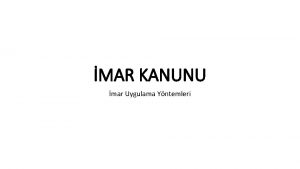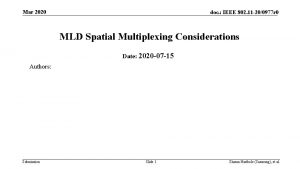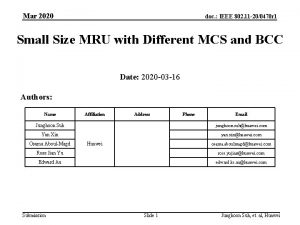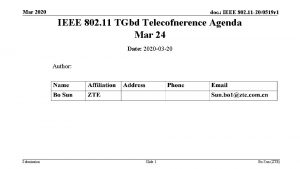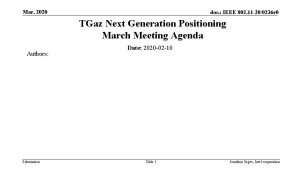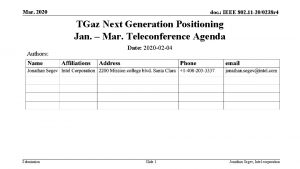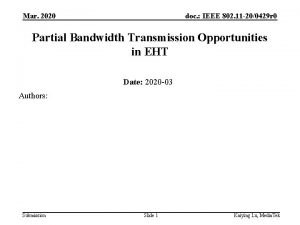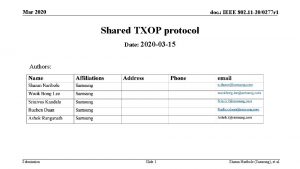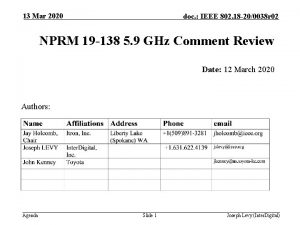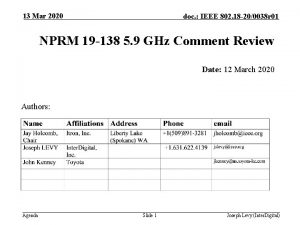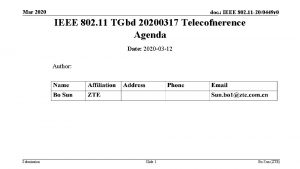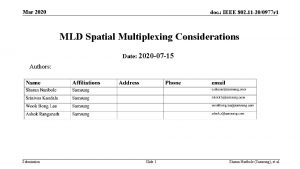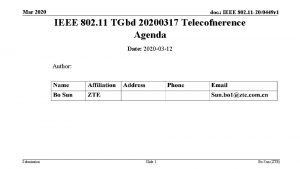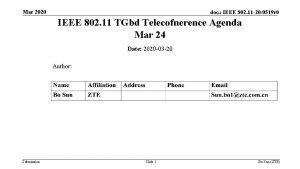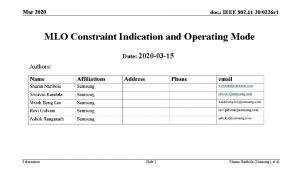Mar 2020 doc IEEE 802 11 20385 r

































- Slides: 33

Mar 2020 doc. : IEEE 802. 11 -20/385 r 0 Some Passive Ranging Considerations • Date: 2020 -03 -11 Authors: Submission Slide 1 Erik Lindskog, Samsung

Mar 2020 doc. : IEEE 802. 11 -20/385 r 0 CIDs 3102 and 3283 CID Subclause P. L Comment Proposed change Resolution 3102 9. 3. 1. 22. 10 46. 0 It would make the implementation of "Common Info Subfield" of the Ranging Trigger Variant" simpler and also provide TSF synchronization for the Passive TB Ranging if we align the two cases of Ranging Trigger for nonpassive and passive case. Change the phrase to "and is set only to 0 in non-secure variant of the TB Ranging measurement exchange" Revised. Make Passive TB Ranging altogether more similar to TB Ranging as described in 1120/385. [For discussion] 3282 9. 3. 1. 22. 10 46. 6 The Trigger Dependent Common Info subfield of the Ranging Trigger frame of subvariant Passive TB Sounding, depicted in Figure 9 -61 d. y, is different from the Trigger Dependent Common Info subfield for the Ranging Trigger variant, depicted in Figure 9 -61 d. x. This subfield is used both the TB and Passive TB Ranging. To reduce the number of options in the standard it would should make these the same. Change the Trigger Dependent Common Info subfield for the Ranging Trigger variant, depicted in Figure 9 -61 d. x. , to be the same as the Trigger Dependent Common Info subfield of the Ranging Trigger frame of subvariant Passive TB Sounding, depicted in Figure 961 d. y. Revised. Make Passive TB Ranging altogether more similar to TB Ranging as described in 1120/385. [For discussion] Submission Slide 2 Erik Lindskog, Samsung

Mar 2020 doc. : IEEE 802. 11 -20/385 r 0 Protocol Choices for Passive TB Ranging • The philosophy for Passive TB Ranging has been to make it as similar to TB Ranging as possible • Ideally, if TB Ranging is supported one would want that a minimum of HW and SW enable support of Passive TB Ranging. • To a large degree this is achieved in 802. 11 az D 2. 0, though there are some aspects that may require special support. • The difference in the Trigger Dependent Common Info subfield of Ranging Trigger Frame for Passive TB Ranging and TB Ranging is an example of a feature that requires special HW or SW support that could be avoided, but we have a few more such protocol choices that maybe can be addressed. Submission Slide 3 Erik Lindskog, Samsung

Mar 2020 doc. : IEEE 802. 11 -20/385 r 0 Trigger Dependent Common Info subfield of Ranging Trigger Frame • In D 2. 0 the Ranging Trigger Frame for Passive TB Ranging contains the Sounding Dialog Token Number whereas this is not the case for TB Ranging. • Seems a good idea to unify these two cases, not the least as the trigger frame may be read by HW. • Options: • Include the Sounding Dialog Token Number also for the TB Ranging case. • Remove the Sounding Dialog Token Number for the Passive TB Ranging case. • The Sounding Dialog Token Number is included for the Passive TB Ranging case in order to aid PSTAs. It only adds a byte to the subfield. Seems a small compromise to also include it for the TB Ranging case. Submission Slide 4 Erik Lindskog, Samsung

Mar 2020 doc. : IEEE 802. 11 -20/385 r 0 Possible Passive TB Ranging Specific HW Dependencies Passive TB Ranging aspects that can require specific HW: • RSTA Transmission of the Primus and Secundus RSTA Broadcast Passive TB Ranging Measurement Report frames with SIFS spacing requirement. • ISTA Transmission of an HE Ranging NDP in response to a Ranging Trigger Frame of subtype Passive TB Sounding • ISTA Transmission of ISTA Passive TB Ranging Measurement Report frames. Submission Slide 5 Erik Lindskog, Samsung

Mar 2020 doc. : IEEE 802. 11 -20/385 r 0 RSTA Transmission of the Primus and Secundus RSTA Broadcast Passive TB Ranging Measurement Report frames with SIFS spacing requirement Submission Slide 6 Erik Lindskog, Samsung

Mar 2020 doc. : IEEE 802. 11 -20/385 r 0 Allow non-SIFS Tx of RSTA LMR Specifics • Allow for the Primus and Secundus RSTA Broadcast Passive TB Ranging Measurement Report frames to be sent without the SIFS spacing requirement. – That is allow these frames to be sent as regular frames, with contention, nominally within the availability window reserved for the (Passive) TB Ranging. • However, still recommend to send these frames with SIFS spacings. Submission Slide 7 Erik Lindskog, Samsung

Mar 2020 doc. : IEEE 802. 11 -20/385 r 0 ISTA NDP Transmission Submission Slide 8 Erik Lindskog, Samsung

Mar 2020 doc. : IEEE 802. 11 -20/385 r 0 Negotiation of ISTA NDP PPDU • Add negotiation of the ISTAs UL Ranging NDP type for Passive TB Ranging exchanges: – Enable to ISTA to request the UL Ranging NDP type to be • HE Ranging NDP, or • HE TB Ranging NDP, or • No Preference (i. e. the ISTA is OK with responding with either NDP type) – Allow the RSTA to make the final decision on what UL Ranging NDP type the ISTA shall use. • If the ISTA can send an HE Ranging NDP, then the RSTA should select that. Submission Slide 9 Erik Lindskog, Samsung

Mar 2020 doc. : IEEE 802. 11 -20/385 r 0 Restriction on ISTAs HE TB Ranging PPDU • Allow the RSTA to announce a restriction on ISTAs Passive TB Ranging UL NDP HE TB PPDU type in the RSTA Availability Window element in its beacon frame. • This can make it simpler for a PSTA to receive the ISTAs HE TB Ranging NDPs as it can preprogram the parameters required for receiving the HE TB PPDU (that are not contained in the HE TB PPDU itself). • Should only need to set a restriction on the number of space-time-streams, N_sts, in the HE TB PPDU. Submission Slide 10 Erik Lindskog, Samsung

Mar 2020 doc. : IEEE 802. 11 -20/385 r 0 PSTA reception of restricted HE TB PPDU Submission Slide 11 Erik Lindskog, Samsung

Mar 2020 doc. : IEEE 802. 11 -20/385 r 0 PSTA reception of restricted HE TB PPDU In order to receive an HE TB PPDU, the Rx PHY needs to be preconfigured with some PPDU parameters that are not contained in the HE TB PPDU itself but normally are specified in the TXVECTOR for the preceding transmitted trigger frame. These parameters are conveyed on the one hand to the Rx PHY of the RSTA transmitting the trigger frame and in the trigger frame itself transmitted to an ISTA. For the PSTA to receive the HE TB PPDU, it normally need to take the parameters from the preceding trigger frame and pass those parameters on to its Rx PHY. This is a quick turnaround from receiving a frame and using its decoded content for the reception of the next PPDU. This may require specialized HW. When the format of the HE TB PPDU is restricted, as we here propose, the PSTA can ahead of time pass those parameters to its Rx PHY. For example, the parameters to receive an HE TB PPDU ranging can be passed to the PSTA’s Rx PHY when it enters the availability window for the (Passive) TB Ranging, as it here is not required to be able to receive any other HE TB PPDUs. Submission Slide 12 Erik Lindskog, Samsung

Mar 2020 doc. : IEEE 802. 11 -20/385 r 0 ISTA Transmission of ISTA Passive TB Ranging Measurement Report frames. Submission Slide 13 Erik Lindskog, Samsung

Mar 2020 doc. : IEEE 802. 11 -20/385 r 0 ISTA LMR format An ISTA may not without special HW be able to transmit an ISTA Passive TB Ranging Measurement Report frame in response to the RSTA’s Ranging LMR Trigger Frame. Options: • Allow the ISTA to, as in a TB Ranging exchange, send its LMR to the RSTA in a Location Measurement Report frame, or • For both Passive TB Ranging and RB Ranging exchanges, use a frame that is a unification of the – Location Measurement Report frame, and the – ISTA Passive TB Ranging Measurement Report frame Submission Slide 14 Erik Lindskog, Samsung

Mar 2020 doc. : IEEE 802. 11 -20/385 r 0 Merging Passive and Active Ranging Submission Slide 15 Erik Lindskog, Samsung

Mar 2020 doc. : IEEE 802. 11 -20/385 r 0 Merging Active and Passive Ranging • Another way to make Passive TB Ranging more similar to TB Ranging can be to make Passive TB Ranging an exchange variant within the TB Ranging protocol, rather than as in D 2. 0, being a separate protocol. • This has the additional advantage in that it can enable new ranging use cases. Submission Slide 16 Erik Lindskog, Samsung

Mar 2020 doc. : IEEE 802. 11 -20/385 r 0 Making Passive TB Ranging part of TB Ranging Submission Slide 17 Erik Lindskog, Samsung

Mar 2020 doc. : IEEE 802. 11 -20/385 r 0 Making Passive TB Ranging part of TB Ranging – 1(2) In D 2. 0, Passive TB Ranging, even though very similar to TB Ranging, is essentially a ranging protocol of its own. Seems rather than having Passive TB Ranging be a separate ranging protocol, we could make Passive TB Ranging exchanges variant exchanges within the TB Ranging protocol. An ISTA would request a Passive TB Ranging exchange within an RTSA’s TB Ranging exchange. (The RSTA would select which TB Ranging occurrence to place the ranging in. ) If Passive TB Ranging exchanges are present, the broadcasting of the Primus and Secundus RSTA Broadcast Passive TB Ranging Measurement Report frames would be added at the end of the TB Ranging frame sequence. Submission Slide 18 Erik Lindskog, Samsung

Mar 2020 doc. : IEEE 802. 11 -20/385 r 0 Making Passive TB Ranging part of TB Ranging – 2(2) Likewise, when serving Passive TB Ranging exchanges, the RSTA includes a Passive TB Ranging Availability Window element in its beacon frame body such that stations that only listen, passive STAs or PSTAs, can get information about when the Passive TB Ranging exchanges occur. With Passive TB Ranging exchanges being part of a regular TB Ranging exchange sequence, the ISTAs performing Passive TB Ranging exchanges would (optionally) measure and report the TOAs of the ranging NDPs from other ISTAs participating in the same TB Ranging exchange sequence and themselves performing Passive TB Ranging exchanges. Submission Slide 19 Erik Lindskog, Samsung

Mar 2020 doc. : IEEE 802. 11 -20/385 r 0 Combined Active and Passive Ranging Submission Slide 20 Erik Lindskog, Samsung

Mar 2020 doc. : IEEE 802. 11 -20/385 r 0 Combining active and passive ranging By combining ‘active’ ranging and passive ranging, or Passive TB Ranging exchanges, new modes of operation and use cases can be achieved. Examples of such use cases are: • Active Passive Ranging: – – • Mobile client STA, to be located, joins RSTAs (Passive) TB Ranging opportunity as an ISTA. Mobile client STA is able to do ‘active’ ranging exchanges with the RSTA as well as client anchor stations participating in the Passive TB Ranging exchange. Enables active ranging to a set of anchor client STAs in a very compressed amount of time. This type of ranging service can already be provided within the Passive TB Ranging protocol. Combined active and passive ranging: – – An RSTA could have a couple of client anchor station participating in its (Passive) TB Ranging. A mobile client STA to be located could then chose to • Perform passive ranging by only listening to the exchanges between the RSTA and the ISTAs performing Passive TB Ranging exchanges – • • – – Submission This leaves the mobile client STA completely anonymous Join as an ISTA performing Passive TB Ranging exchanges with the RSTA and the other ISTAs performing Passive TB Ranging exchanges Join as an ISTA performing TB Ranging exchanges, possibly secure, and also perform passive ranging by listening to the exchanges between the RSTA and the ISTAs performing Passive TB Ranging exchanges. Basically my enabling a couple of client anchor STAs to participate in the (Passive) TB Ranging exchange the flexibility of the ranging services can be greatly increased. This type of ranging service can already be provided with separate Passive TB Ranging and TB Ranging sessions, though there could maybe be some benefits in being able in merging the two protocols. Slide 21 Erik Lindskog, Samsung

Mar 2020 doc. : IEEE 802. 11 -20/385 r 0 Active Passive Ranging Example Scenario Anchor Client - ISTA Client STA to be located – mobile ISTA Access Point - RSTA Anchor Client - ISTA Submission Slide 22 Erik Lindskog, Samsung

Mar 2020 doc. : IEEE 802. 11 -20/385 r 0 (Passive) TB Ranging used for Active Passive Ranging LMR broadcasting (Details TBD) Green arrows – Regular ranging frame exchanges Responder STA Client Anchor Initiator STA 1 PR PR Mobile Initiator STA 2 (to be located) UL NDP TF Poll TF DL NDP A DL NDP RSTA to ISTA LMR Frame ISTA to RSTA LMR TF 1 Frame 2 ISTA to RSTA LMR UL NDP ISTA to RSTA LMR Blue arrows – Extra listening opportunities Frames in TB Ranging protocol Enables client station receiving the NDPs and LMR reporting to calculate its location using TDOA relations. Submission Slide 23 Extra frames for Passive Location Ranging Protocol Erik Lindskog, Samsung

Mar 2020 doc. : IEEE 802. 11 -20/385 r 0 Combined Active and Passive Ranging Example Scenario Anchor Client - ISTA Active ranging (Possibly secure? ) Passive ranging reception (Not all marked) Client STA to be located – mobile ISTA Access Point - RSTA Anchor Client - ISTA Submission Slide 24 Erik Lindskog, Samsung

Mar 2020 doc. : IEEE 802. 11 -20/385 r 0 Supplemental Material Submission Slide 25 Erik Lindskog, Samsung

Mar 2020 doc. : IEEE 802. 11 -20/385 r 0 HE TB PPDU Parameters Submission Slide 26 Erik Lindskog, Samsung

Mar 2020 doc. : IEEE 802. 11 -20/385 r 0 Missing HE-SIG-A parameters in an HE TB PPDU as compared to an HE SU PPDU • • • Beamchange – Set to 0 UL/DL – Set to ‘UL’ HE-MCS – Irrelevant for NDP DCM – Irrelevant for NDP GI+LTF size – Conveyed in TF – However the LTF type and GI size is already restricted for HE TB Ranging NDPs in 802. 11 az draft 2. 0. • NSTS and Midamble Periodicity – Conveyed in TF – Midamble Periodicity is irrelevant for NDP. • Coding – Irrelevant for NDP Submission Slide 27 Erik Lindskog, Samsung

Mar 2020 doc. : IEEE 802. 11 -20/385 r 0 Missing HE-SIG-A parameters in an HE TB PPDU as compared to an HE SU PPDU • • • LDPC Extra Symbol Segment – Irrelevant for NDP STBC – Irrelevant for NDP Beamformed – Irrelevant for NDP PE Disambiguity – Irrelevant for Ranging NDP reception. Doppler – Irrelevant for NDP Submission Slide 28 Erik Lindskog, Samsung

Mar 2020 doc. : IEEE 802. 11 -20/385 r 0 Parameters for HE TB PPDU reception in Trigger Frame - 1(2) • UL Length - L-SIG Length field in HE TB PPDU – This parameter also controls the packet extension used. • CS Required – Would have to preset this to zero • UL BW – Is also in the HE TB PPDU HE SIG A field • GI And LTF Type – For an HE TB Ranging NDP this is already restricted to 2 x HE-LTF and 1. 6 us GI in 802. 11 az D 2. 0. • MU-MIMO LTF Mode – For an HE TB Ranging NDP for Passive TB Ranging we can restrict this to HE single stream pilot HE-LTF mode. • Number Of HE-LTF Symbols And Midamble Periodicity – Allow the RSTA to restrict the number of HE-LTF symbols in the HE TB Ranging PPDUs and announce it in the beacon frame. The Midamble Periodicity is irrelevant for an HE TB Ranging NDP. Submission Slide 29 Erik Lindskog, Samsung

Mar 2020 doc. : IEEE 802. 11 -20/385 r 0 Parameters for HE TB PPDU reception in Trigger Frame - 2(2) • • • UL STBC – Irrelevant for NDP LDPC Extra Symbol Segment – Irrelevant for NDP AP Tx Power – Irrelevant for PSTA reception Pre-FEC Padding Factor – Irrelevant for NDP PE Disambiguity – Irrelevant for reception of an HE TB Ranging NDP. • UL Spatial Reuse – Preset to all zeros = No spatial reuse for an HE TB Ranging NDP for Passive TB Ranging. • Doppler – Irrelevant for NDP Submission Slide 30 Erik Lindskog, Samsung

Mar 2020 doc. : IEEE 802. 11 -20/385 r 0 PSTA Preprogramming of PPDU parameters for reception of an HE TB Ranging NDP - 1(2) The idea is that the RSTA restricts the format of the HE TB Ranging NDP, e. g. restricts the number of spatial streams, and announces this restriction it its beacon frame. The PSTA can then preprogram its PHY to fill in the missing Rx parameters for the HE TB PPDU to match the specific restriction. This pre-programming for reception of HE TB PPDU’s is likely to be similar to the preprogramming an AP or SAP does when it send out a trigger frame to receive an HE TB PPDU. With some luck the PSTA can with existing HW comply with this, or it may only need to make smaller changes in its HW to be able to comply with this. Submission Slide 31 Erik Lindskog, Samsung

Mar 2020 doc. : IEEE 802. 11 -20/385 r 0 PSTA Preprogramming of PPDU parameters for reception of an HE TB Ranging NDP - 2(2) HE TB PPDU Rx parameter preprogramming: • Beamchange – Set to 0. (No beamforming on a Ranging NDP. ) • UL/DL –Set to ‘UL’ • HE-MCS –Irrelevant for NDP • DCM –Irrelevant for NDP • GI+LTF size –Preset to a GI size of 1. 6 us and LTF size matching the restriction announced by the RSTA. • NSTS (and Midamble. Periodicity) – Preset N_sts to match the restriction announced by the RSTA. The Midamble. Periodicity is irrelevant for NDP. • Coding –Irrelevant for NDP • LDP Extra Symbol Segment –Irrelevant for NDP • STBC –Irrelevant for NDP • Beamformed–Irrelevant for NDP • PE Disambiguity–Irrelevant for Ranging NDP reception. • Doppler –Irrelevant for NDP. Submission Slide 32 Erik Lindskog, Samsung

Mar 2020 doc. : IEEE 802. 11 -20/385 r 0 Thank You! Submission Slide 33 Erik Lindskog, Samsung
 Bridges from 802.x to 802.y
Bridges from 802.x to 802.y Bridges from 802.x to 802.y
Bridges from 802.x to 802.y 802 ieee
802 ieee 802 ieee
802 ieee Ieee 802 family
Ieee 802 family Wlan standards
Wlan standards Ieee 802 standard
Ieee 802 standard Ieee 802
Ieee 802 Ieee 802 3 compliance
Ieee 802 3 compliance Arquitetura ieee 802
Arquitetura ieee 802 Bluetooth ieee 802
Bluetooth ieee 802 Ieee mass 2020
Ieee mass 2020 Format rps dikti 2019
Format rps dikti 2019 Format matrik rpjm desa
Format matrik rpjm desa Rejestr wypadków przy pracy 2020 doc
Rejestr wypadków przy pracy 2020 doc 802-11-iapp
802-11-iapp 802 15
802 15 Project 802 in data communication network
Project 802 in data communication network Wlan 802
Wlan 802 Geo 802
Geo 802 Kamstrup multical 802
Kamstrup multical 802 09 802 0561
09 802 0561 Project 802
Project 802 802-11-wireless-security
802-11-wireless-security 802 5
802 5 Wireless lan 802
Wireless lan 802 Ethernet 802
Ethernet 802 802 eap
802 eap Ccna 640-802
Ccna 640-802 802 3
802 3 802 16
802 16 802 11
802 11 Ssin-802
Ssin-802 802 11 b
802 11 b











